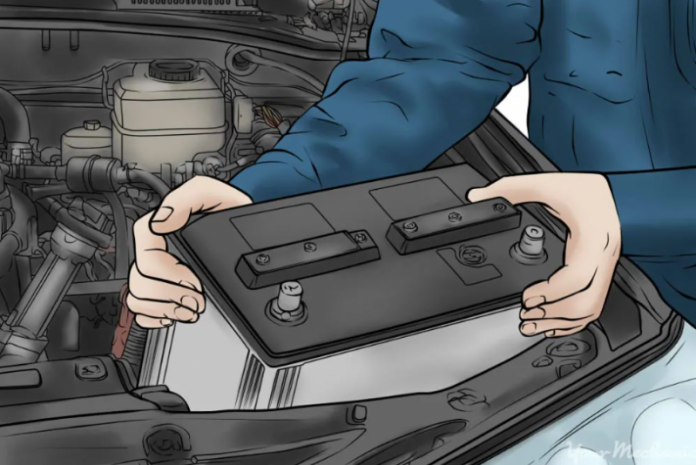Changing a car battery at home is an easy way to save cash on car maintenance. You can buy your new battery anywhere, including online, and install it yourself instead of paying high garage or service center prices. Car batteries typically cost between $50 and $200 depending on your vehicle. Once you have the battery, the process typically takes 30 minutes to complete.
Important: Always consult with your owner’s manual to confirm the exact battery location and the specifications for a replacement.
How to be sure a car battery needs to be replaced
When your car won’t start, there are several electrical issues that could be the problem. Jumpstarting the car can give you enough charge to get you where you need to go, but it can also mask electrical problems that drain your battery, regardless if it’s old or new.
You need to test the battery before replacing it. There are other causes of a no-start or a dead battery, including problems with the alternator, a short circuit or other electrical issue. If these are not addressed, the new battery will run down and the car will not start again.
In general, car batteries typically last about 3 to 4 years. Factors like heat, heavy use, and unsecured battery hold-downs can all impact how long a battery lasts.
Signs of bad battery include:
Zero response when you turn the key. When nothing happens and there are no warning lights on the dashboard when you turn the key, that means the car has a dead battery. Starter cranks slower than normal. When you turn the key, does the starter motor crank slowly, struggle or hesitate? These are signs the battery needs to be checked.
Dim headlights. Dim headlights when the car is off can be a sign of a bad battery. Dim headlights when a car is running can be a sign of a bad alternator.
Battery or charging system warning lights appear. Some cars have warning lights that tell you the battery is dead or about to die. Battery has cracks or leaks. If your battery has any cracks, leaks or damage, it should be replaced immediately.
An inexpensive electronic device called a multimeter can be used to measure the voltage of the battery. This can help determine whether it needs replacement.
Quick tip: It’s always smart to check your roadside assistance plan offerings. For example, AAA tow trucks carry a battery tester, while some plans offer free battery testing.
What you need
Replacement battery
Eye protection and protective work gloves
Ratchet and socket, wrench and locking pliers. Common sizes for battery terminal and connector bolts are 5/16” (10mm) and ½” (13mm)
Wire brush and steel wool
Battery cleaner spray and battery anti-corrosive gel
Step 1: Find the car battery
Put the car in park, turn it off, and remove the key. Before you locate the battery, make sure the engine has cooled down. Most car batteries are in the front, mounted on a plastic or metal tray, under the hood. Some cars have the battery in the trunk.
Step 2: Locate and disconnect the battery terminals
Batteries have two terminals where the cables are connected. They may be covered by plastic covers. There will be a black one (negative) and a red one (positive). The terminals may also be marked with + for positive and – for negative.
Always disconnect the negative cable first. Wearing work gloves and eye protection and using a wrench, loosen the bolt that tightens the negative connector to the battery terminal. Once loose, gently twist the cable connector back and forth as you lift it up to remove it from the battery terminal.
Next, remove the positive cable. Using the wrench, loosen the bolt that tightens the cable to the battery terminal. Once loose, gently twist the cable connector back and forth as you lift it up to remove it.
Step 3: Remove the old battery
Car batteries are secured with a metal bar over them or a metal clamp at the base. Loosen the bolt that secures the holding bar or clamp so you can remove it and lift the battery out of the car. Batteries have caustic liquid inside, so be sure to always keep it upright.
Quick tip: To ensure you don’t forget anything, take a photo with your phone to remember what the connections look like when the battery is fully set up.
Step 4: Clean the battery tray and terminal connectors
Terminal connectors corrode over time, and now is a great opportunity to give them a thorough cleaning. Using battery cleaner and a wire brush, clean the connectors and the battery tray. Alternatively, you can use a baking soda paste by mixing two tablespoons of baking soda with a teaspoon of water. Use steel wool to clean inside the connectors then thoroughly dry everything. Inspect the cables and connectors to ensure they are not damaged or frayed.
Step 5: Install and secure the new battery
Double-check to make sure that the position of the new battery matches the red and black terminals. Lower the new battery into the car and onto the mounting shelf. Re-attach the clamp or hold-down bar and tighten the bolt to secure it. Before reconnecting the terminals, consider using protective felt washers or some battery anti-corrosive protection gel on both terminals.
Always connect the positive cable to a new battery first. Be sure the connector is pushed all the way down on the terminal. Tighten the bolt. Repeat the same steps for the negative connector to the negative terminal.
Step 6: Close the hood and start the car
New car batteries normally come charged and are ready to go right away.
Recycling used car batteries
If you change a car battery yourself, remember that they cannot be thrown away in ordinary trash. The old battery can be returned to the seller of the new battery, as sometimes a refundable core fee is charged.
In most states, any retailer who sells new batteries is required to accept used ones for recycling. Check with your local auto parts store. Place the old battery in several trash bags and be sure to always keep it upright. Do not keep it, batteries emit toxic gasses and can leak. Properly dispose of it as soon as possible.
Conclusion
Changing your car battery yourself is an easy way to save money on car maintenance. Be sure to properly test the battery to make sure it needs replacing. Remove the negative connector first, then the positive connector from the old battery and remove it. Install the new battery then connect the positive connector first and finally the negative connector last. Dispose of the old battery properly at an auto parts store or recycling center. However, a loose battery or loose electrical connections can be very dangerous. If you’re not comfortable doing any part of this process, most auto parts stores will install batteries you buy there for free.





